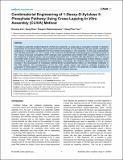| dc.contributor.author | Zou, Ruiyang | |
| dc.contributor.author | Zhou, Kang | |
| dc.contributor.author | Stephanopoulos, Gregory | |
| dc.contributor.author | Too, Heng Phon | |
| dc.date.accessioned | 2014-01-10T18:54:30Z | |
| dc.date.available | 2014-01-10T18:54:30Z | |
| dc.date.issued | 2013-11 | |
| dc.date.submitted | 2013-07 | |
| dc.identifier.issn | 1932-6203 | |
| dc.identifier.uri | http://hdl.handle.net/1721.1/83864 | |
| dc.description.abstract | The ability to assemble multiple fragments of DNA into a plasmid in a single step is invaluable to studies in metabolic engineering and synthetic biology. Using phosphorothioate chemistry for high efficiency and site specific cleavage of sequences, a novel ligase independent cloning method (cross-lapping in vitro assembly, CLIVA) was systematically and rationally optimized in E. coli. A series of 16 constructs combinatorially expressing genes encoding enzymes in the 1-deoxy-D-xylulose 5-phosphate (DXP) pathway were assembled using multiple DNA modules. A plasmid (21.6 kb) containing 16 pathway genes, was successfully assembled from 7 modules with high efficiency (2.0 x 10[superscript 3] cfu/ µg input DNA) within 2 days. Overexpressions of these constructs revealed the unanticipated inhibitory effects of certain combinations of genes on the production of amorphadiene. Interestingly, the inhibitory effects were correlated to the increase in the accumulation of intracellular methylerythritol cyclodiphosphate (MEC), an intermediate metabolite in the DXP pathway. The overexpression of the iron sulfur cluster operon was found to modestly increase the production of amorphadiene. This study demonstrated the utility of CLIVA in the assembly of multiple fragments of DNA into a plasmid which enabled the rapid exploration of biological pathways. | en_US |
| dc.description.sponsorship | Singapore-MIT Alliance | en_US |
| dc.language.iso | en_US | |
| dc.publisher | Public Library of Science | en_US |
| dc.relation.isversionof | http://dx.doi.org/10.1371/journal.pone.0079557 | en_US |
| dc.rights.uri | http://creativecommons.org/licenses/by/2.5/ | en_US |
| dc.source | PLoS | en_US |
| dc.title | Combinatorial Engineering of 1-Deoxy-D-Xylulose 5-Phosphate Pathway Using Cross-Lapping In Vitro Assembly (CLIVA) Method | en_US |
| dc.type | Article | en_US |
| dc.identifier.citation | Zou, Ruiyang, Kang Zhou, Gregory Stephanopoulos, and Heng Phon Too. “Combinatorial Engineering of 1-Deoxy-D-Xylulose 5-Phosphate Pathway Using Cross-Lapping In Vitro Assembly (CLIVA) Method.” Edited by Jorg D. Hoheisel. PLoS ONE 8, no. 11 (November 5, 2013): e79557. | en_US |
| dc.contributor.department | Massachusetts Institute of Technology. Department of Chemical Engineering | en_US |
| dc.contributor.department | Singapore-MIT Alliance in Research and Technology (SMART) | en_US |
| dc.contributor.mitauthor | Zhou, Kang | en_US |
| dc.contributor.mitauthor | Stephanopoulos, Gregory | en_US |
| dc.relation.journal | PLoS ONE | en_US |
| dc.eprint.version | Final published version | en_US |
| dc.type.uri | http://purl.org/eprint/type/JournalArticle | en_US |
| eprint.status | http://purl.org/eprint/status/PeerReviewed | en_US |
| dspace.orderedauthors | Zou, Ruiyang; Zhou, Kang; Stephanopoulos, Gregory; Too, Heng Phon | en_US |
| dc.identifier.orcid | https://orcid.org/0000-0001-6909-4568 | |
| mit.license | PUBLISHER_CC | en_US |
| mit.metadata.status | Complete | |
